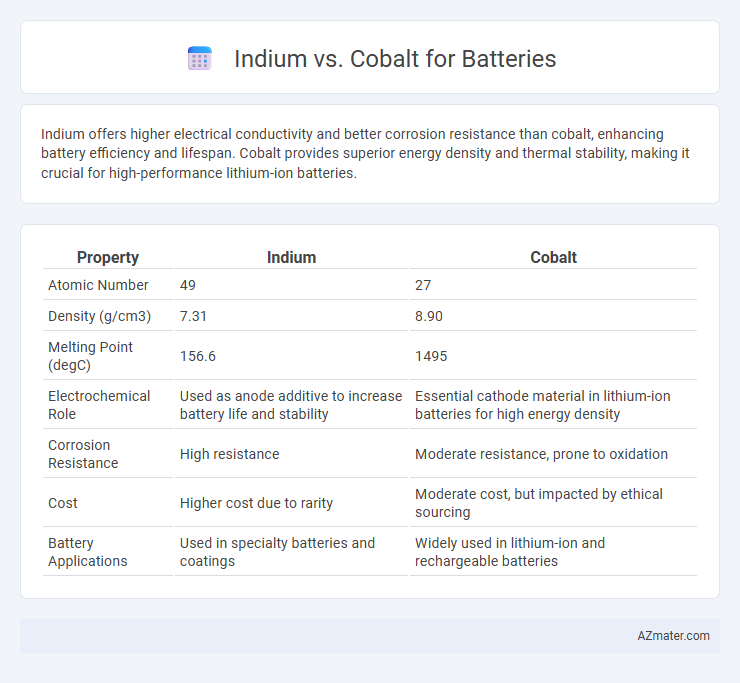Indium offers higher electrical conductivity and better corrosion resistance than cobalt, enhancing battery efficiency and lifespan. Cobalt provides superior energy density and thermal stability, making it crucial for high-performance lithium-ion batteries.
Table of Comparison
| Property | Indium | Cobalt |
|---|---|---|
| Atomic Number | 49 | 27 |
| Density (g/cm3) | 7.31 | 8.90 |
| Melting Point (degC) | 156.6 | 1495 |
| Electrochemical Role | Used as anode additive to increase battery life and stability | Essential cathode material in lithium-ion batteries for high energy density |
| Corrosion Resistance | High resistance | Moderate resistance, prone to oxidation |
| Cost | Higher cost due to rarity | Moderate cost, but impacted by ethical sourcing |
| Battery Applications | Used in specialty batteries and coatings | Widely used in lithium-ion and rechargeable batteries |
Introduction to Indium and Cobalt in Battery Technology
Indium and cobalt are critical materials in advanced battery technology, influencing performance and durability. Indium, known for its high electrical conductivity and corrosion resistance, enhances electrode stability and energy efficiency in battery cells. Cobalt, widely used in lithium-ion batteries, improves energy density and cycle life, making it essential for high-capacity rechargeable batteries in electric vehicles and portable electronics.
Chemical Properties: Indium vs Cobalt
Indium exhibits a lower electronegativity (1.78) compared to cobalt (1.88), influencing their redox behavior in battery applications. Cobalt's multiple stable oxidation states, particularly +2 and +3, facilitate efficient electron transfer and enhance battery cathode performance. Indium's chemical stability and resistance to corrosion offer advantages for anode protection but limit its redox versatility compared to cobalt in electrochemical cells.
Performance Comparison in Batteries
Indium demonstrates superior conductivity and corrosion resistance compared to cobalt, enhancing battery efficiency and lifespan. Cobalt offers higher energy density and better thermal stability, which improves power output and safety in lithium-ion batteries. The choice between indium and cobalt depends on specific battery requirements, balancing durability with energy performance.
Energy Density and Efficiency
Indium and cobalt play distinct roles in battery technology, with cobalt primarily enhancing energy density in lithium-ion batteries through its use in cathode materials like lithium cobalt oxide (LiCoO2), which provide high capacity and longer cycle life. Indium, while less common, is used in battery components such as indium tin oxide for transparent electrodes and can influence efficiency by improving electrical conductivity and stability. Cobalt-based cathodes offer superior energy density, making them critical for high-performance batteries, whereas indium's contribution centers on efficiency improvements in electrode performance rather than direct energy storage capacity.
Safety and Thermal Stability
Indium exhibits excellent thermal stability and resistance to thermal runaway, making it a safer option in battery applications compared to cobalt. Cobalt, while providing high energy density, poses greater risks due to its tendency to overheat and release toxic gases under thermal stress. Prioritizing indium can enhance battery safety by ensuring stable performance during extreme temperature fluctuations.
Availability and Global Supply Chain
Indium is a rare metal primarily produced as a byproduct of zinc mining, with global annual production around 700 metric tons, leading to limited availability and supply chain constraints. Cobalt, sourced mainly from the Democratic Republic of Congo, has a more established supply chain but faces geopolitical and ethical challenges affecting its consistent supply. The global supply of cobalt is significantly larger, approximately 140,000 metric tons annually, yet both metals' availability is crucial for battery technologies and requires strategic resource management.
Environmental Impact and Sustainability
Indium and cobalt exhibit distinct environmental footprints in battery production, with cobalt mining linked to significant ecological degradation, human rights issues, and higher carbon emissions due to extensive extraction processes. Indium, while less abundant and also requiring careful sourcing, generally presents lower toxicity and environmental risks, offering a potential alternative for sustainable battery technologies. Recycling efforts and improved supply chain transparency in both metals are crucial for reducing environmental impact and promoting long-term sustainability in the battery industry.
Cost Analysis: Indium vs Cobalt
Cobalt remains significantly more expensive than indium due to its high demand in lithium-ion battery cathodes and geopolitical supply risks concentrated primarily in the Democratic Republic of Congo. Indium, while less common in batteries, offers a lower-cost alternative with stable pricing linked to its use in LCD screens and semiconductors. The cost per kilogram of cobalt can be three to five times higher than indium, making indium attractive for niche battery applications seeking reduced material expenses.
Innovations and Future Prospects
Indium's unique properties such as high electrical conductivity and corrosion resistance make it a promising material for enhancing battery electrodes and solid-state batteries, driving innovations toward longer lifespan and higher energy density. Cobalt remains a critical component in lithium-ion batteries due to its stability and energy retention capabilities but faces sustainability and ethical sourcing challenges pushing research towards cobalt-free or reduced-cobalt alternatives. Future prospects include combining indium's electrochemical advantages with cobalt's established performance to develop next-generation batteries that balance efficiency, safety, and environmental impact.
Conclusion: Which is Better for Batteries?
Cobalt remains the preferred choice for battery cathodes due to its higher energy density, thermal stability, and widespread industrial adoption in lithium-ion batteries. Indium, while offering unique electronic properties and corrosion resistance, is less suited for battery applications because of its scarcity, higher cost, and lower electrochemical performance compared to cobalt. Therefore, cobalt's established supply chain and superior battery performance metrics make it the better material for current and future battery technologies.

Infographic: Indium vs Cobalt for Battery
 azmater.com
azmater.com